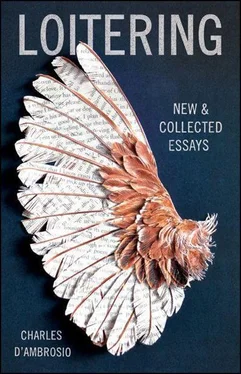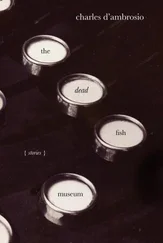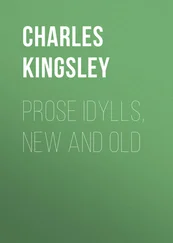In house #19 I find an icy aspect to the arrangement of family artifacts and like Keats before the Grecian Urn I can’t quite puzzle out the story. Photos have been framed and set out on tables and shelves but the pictures are of those same corny people who haven’t aged a bit since they came with your first cheap wallet. Who are these blonde women with unfading smiles? Whose bright kids are these? What happy family is this? In the kitchen two ice cream sundaes sit on the counter. Those sundaes will never melt, nor will they be eaten. The cookbook in the kitchen is open to a recipe for blueberry pancakes but in the living room a bottle of wine and two glasses wait on a coffee table. What time of day is it?
In house #17 I encounter the only joke on the lot: EAT MORE PORK is stenciled on the side of a wooden chicken.
In house #12 it’s Christmas.
In house #16 you’ve got a pastoral leitmotif in the prints on the walls and the folksy bric-a-brac on the shelves. I linger longest here. Outside I hear real church bells ring, dull and somewhat muffled through the dense (R-41) insulation. It’s as though the bell is being clapped with a cotton tongue. Through the window I see a wedding party. I feel like a voyeur watching the bride and groom, inverting the business of a Peeping Tom. I have to sneak up on regular life. As much as rote irony informs my take on this, I’ve been imagining living in these homes, where I’d plunk one down, etc. What would I be able to see out my front window? A wedding! In the master bedroom down the hall the unwrinkled bed is empty, clean, without misery or past. Happy love has no history and this bed is its home. I’d like to come back some night and fuck in one of these modular houses. The perfection is inviting but really I just want to soil the sheets. I want to bring exhaustion into the equation. All these houses are waiting for the future to come and haunt them.
I’ve overstayed. On my way out I stop in the kitchen. A plastic dinner is set on the counter. Tonight and every night in this home where time has stopped and there’s no story or words we’re having fake turkey, we’re having fake carrots too, fake carrots and asparagus and baked potatoes with sour cream and chives, and afterward, after this tableau vivant of bounty is cleared away, we’ll grind coffee by hand in the wooden mill on the counter and serve it in the living room by the basket of logs for which, in #16 at least, there is no hearth.
Our boy will fall asleep on the rug and eventually I’ll lift and carry him sleepily to the pine-log bed in his room, and after his prayers I’ll tuck the quilt around his chin and tell him I love him.
Our girl will go to her room too, say her prayers too, beneath a picture of a roan horse, but in this case I’ll only look on, from the doorway, as you bend to kiss her cheek.
Then you and I will go down the hall to sleep in that bed where no one’s ever been before. 
Now what remains of the place is an anonymous wall of brick, but not so long ago my uncle ran a bar at 112 1/2 Clinton Street, the half being our family’s share in the City of Big Shoulders, Chicago. If the Sears Tower were considered the gnomon of a sundial and you were inclined to tell time by organizing shadows, then the bar was located at roughly ten o’clock in the morning. By midmorning the shadows swept in, the air darkened and the streets turned silty, creating sunken rivers of early night, murky and unpromising to most people but suiting just fine the shady temper of the hardcore drinkers and gamblers the bar catered to. In fact they came precisely for that halfness, that demimonde aspect of the address. The building itself occupied an alley that had formerly served as a cattle run from the trains to the stockyards and packing plants on the South Side. Soon after the butchering ended the bar opened for business. It must have been a big improvement not to taste blood in the wind, blown over the city from the slaughterhouses. When I lived in Chicago those old abattoirs, long ago lost to history, had become inviolate and fixed in legend, but the city was changing again.
It was destroying itself, or sloughing off its old industrial self, and many of the brick warehouses and factory buildings in the neighborhood, gutted and windowless, deserted, were no better than caves hollowed from rock, with doors gaping open blackly, home to the homeless, the vast vacant interiors lit only by the light of fires burning in oil drums. In seeking the future a city like Chicago wrecks itself and returns to stone, at least briefly. There were piles of rubble such as you imagine in war, but the absence of declared enemies, and the lethargic unfolding of time, its leisurely pace, kept people from seeing the scale of the shift as catastrophic. Factories and warehouses and hotels, these old muscular hopes came down in heaps of brick and mortar, of pulverized concrete and cracked limestone, and then those cairns of rock, in turn, were cleared off to become barren lots as flat and featureless as the prairie they’d supplanted. Now brand-new buildings staunchly occupy those spaces, but for the duration, for the brief winter, spring, and summer I lived and worked next door to the bar, there was the constant gray taste of mortar on my tongue, my lips burning from the lime it was laced with, as clouds of dust were set adrift by each new day’s demolition.
Brick is relocated earth, and the streets of a city like Chicago re-create a riverbank, in this case the clay banks of both the Mississippi and Ohio Rivers, where a good portion of Chicago’s brick originally came from. The mining of clay is often referred to as “winning,” a curious kind of victory, considering the clay used in brickmaking comes from the Carboniferous period, a subcategory of the Paleozoic, some 340 million years ago. Such a vast span of time would seem to temper any man’s sense of triumph. It was during the Carboniferous that amniote eggs allowed ancestral birds and reptiles to reproduce on land; flight was first achieved, too, as insects evolved wings. And then something happened, something happened to the birds and mammals and reptiles, to the nascent flying insects, to the whole ambition and direction of that geologic age. Everything died off and disappeared in that silent way only an eon can absorb and keep secret.
And yet with death the seedless vascular plants that existed in tropical swamp forests provided the organic material that became coal. These dead plants didn’t completely decay but instead turned to peat bogs. When the sea covered the swamps, marine sediment covered the peat, and eventually intense pressure and heat transformed these organic remains into coal and shale. Curiously, burning brick in kilns only extends and completes the process epochal time itself used to form the source clay. Brick manufacturers use coal to fire and harden the clay, removing moisture and the last memory, the last vestiges of fluidity from the brick. (In fact there’s a taxonomy of bricks based on how burnt they are: clinker brick, nearest the fire, becomes vitrified, glassy and brittle; red brick is the hardest and most desirable product of the kiln; and salmon brick, sitting farthest from the fire, is underburned and soft, unsuitable for exposed surfaces.) The obvious advantage of brick as a building material is that it’s already burned, which accounts for its presence in Chicago after the fire of 1871. Brick transformed the city, ushering in an era of industrial greatness, completing — no, not completing, but extending — extending a process that began with a mysterious extinction, a vast unimagined loss.
During my time in Chicago my day job was to load cars and trucks with reproduction furniture, the historical imperative of which had vanished, vaguely, around the turn of the century. Nonetheless shoppers from the suburbs drove to the city to browse the warehouse, its four floors and forty thousand square feet of fake antiques. They bought oxblood leather wing-backs, banker’s lamps, baker’s racks, oak iceboxes, old phones with a crank on the side that would, with a turn or two, summon the operator. The furniture was hokey, farmy, Depressiony. Of course none of the people who shopped the warehouse were cutting blocks of winter ice to haul by horse and wagon and then pack and preserve in layers of straw for the long hot summer. They lived in the suburbs, they had appliances. It was curious and teleologically baffling. Why buy a phone you have to crank by hand when you can punch buttons to place your call? Why a wrought-iron baker’s rack for men and women whose cookies and bread did their cooling at the factory? Why buy an antique that was hardly two weeks old?
Читать дальше













